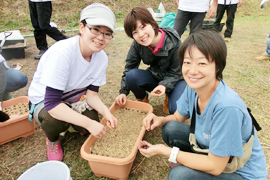The Mitsui & Co. Environment Fund
Introduction to Grant Projects
INDEX="127"
NAME="Creating the foundations for a stable supply of local seedlings for revegetating disaster areas"
TYPE="活動助成,"
YEAR="2013年度,"
AREA="日本全国,東北,"
KIND="NPO,"
ORG="Ishinomaki Kankyo Net"
Ishinomaki Kankyo Net
Creating the foundations for a stable supply of local seedlings for revegetating disaster areas
Activity grant
- Project Description
Raising and planting seedlings to revegetate coastal areas damaged by tsunami and help prevent future disasters. Seedlings from plants that are native to these areas are carefully selected and hand-raised by local people, increasing their appreciation for nature. The concept behind this is that in addition to conserving biodiversity and ecosystems and providing a disaster prevention function, these newly planted trees will have roots in the local community and will send a message of sustainable hope and greenery for children of the future. Over many years people will come together regardless of age, gender, and nationality in order to plant these trees.
- Grant year
- FY2013 Activity Grants
- Grant term
- 2 years
October 2013 - September 2015
- Grant amount
- 7,000,000 yen
- Activity region
- Ishinomaki area, Miyagi Prefecture, Japan

Overview of the Organization

- Representative
- Hisashi Takahashi, Director
- Establishment
- 2005
- Establishment purpose
- The group aims to form a society which supports both the natural and human living environments through education and practical activities relating to the environment in the area around Ishinomaki in order to leave a better environment for the people of the future.
- Main area of activity
- The Ishinomaki area, Miyagi Prefecture, Japan
- Staff
- 1 part-time staff member and 45 full members
- Annual operating budget
- 12.12 million yen in 2011, 4.04 million yen in 2012
- WEB site
- http://ishi-kankyonet.org/
- Collaborating organizations
- Pur Projet, NPO MAKE THE HEAVEN
- Recent activities
-
- Tohoku planting project
Planting trees in rememberance of those lost in the disaster and as a representation of friendship with the people around the world who showed their support in the aftermath. The trees also play a role in providing a barrier to reduce destructive force when a tsunami hits as well as a fixture for reducing carbon dioxide levels. - Restoring disaster hit environments
Using microbial materials to improve living environments and restore industrial infrastructure following disasters. Collaborating to expand activities and search for new rehabilitation possibilities.
- Tohoku planting project